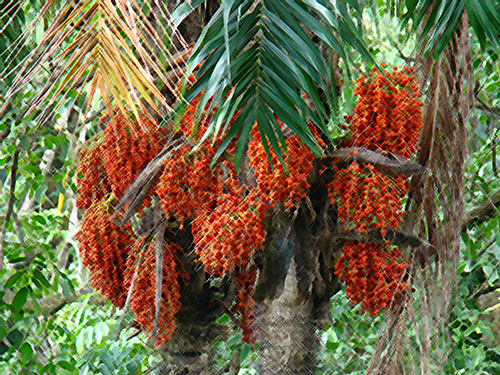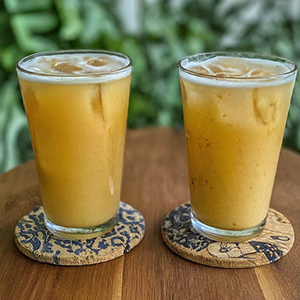Contents
Peach palm is a fruit consumed in Central and South America before the arrival of European colonizers. Today it forms part of the traditional diet of countries such as Columbia and Venezuela.

Scientific Facts
- Scientific name – Bactris gasipaes L.
- Scientific synonym – Guilelma gasipaes (H.B.K) Bailey.
- Other names – Pejebaye.
- Spanish – Pejibaye pijibay.
- German – Pfirsich-palmfrucht
- Description – Fruit of the peach palm, a tree of the botanical family Palmae.
- Environment – Found in tropical regions of South America, particularly in Columbia, Venezuela, and Ecuador.
Peach Palm Health Benefits

Carbohydrates predominate in the peach palm composition representing more than forty percent of their weight. The bulk of this is starch, although there are also simple carbohydrates or sugars. They also contain fats and proteins, although in lower proportions than carbohydrates.

They contain a sizable amount of vitamin A in the form of carotenoids, which are pretty heat-resistant, and, in lower proportion, vitamins B1, B2, C, and niacin. As for minerals, they contain lesser amounts of calcium, phosphorus, and iron.
Because of its high starch content, peach palm is a very high-energy fruit. Each gram of starch provides the body with 4 calories when metabolized. Peach palm fruit is indicated in the following cases:
GROWTH PERIODS (childhood, adolescence).
ATHLETES are individuals participating in physical labor, with a more significant energy requirement each time.
MALNUTRITION, undesired weight loss, recovery from debilitating disease.
How to Use and Prepare Peach Palm
- Raw – The pulp of this fruit is starchy with a pleasant flavor.
- Boiled—This is how this fruit is typically prepared. It is cooked for 30 to 45 minutes in salted water. After it has been peeled, it is served with a variety of sauces or with cottage cheese.
- Roasted – Roasted peach palm has a delightful taste.
DISCLAIMER: All content on this website is presented solely for educational and informational objectives. Do not rely on the information provided as a replacement for advice, diagnosis, or treatment from a qualified medical expert. If you are pregnant, nursing, or have any preexisting medical concerns, talk to your doctor before using any herbal or natural medicines.
REFERENCES
- George D. Pamplona-Roger, M.D. “Encyclopedia of Foods and Their Healing Power.” George D. Pamplona-Roger, M.D. Encyclopedia of Foods and Their Healing Power. Trans. Annette Melgosa. Vol. 2. Chai Wan: Editorial Safeliz, 2005. 296. Print.
- Yuyama et al. (2005) Pejibaye Palm Fruit Contribution to Human Nutrition. Palms. Vol. 36(2).
- Bezerra & Silva (2016) The fruit of a peach palm (Bactris gasipaes) and its technological potential: an overview. Ciencia y Tecnología de Alimentos.
- Espinosa-Pardo et al. (2014) Physicochemical and nutritional characterization of peach palm (Bactris gasipaes Kunth) fruits from Ecuador. Food Chemistry.
- Jatunov et al. (2010) Content of carotenoids in the pulp of peach palm (Bactris gasipaes HBK) from western Amazonia, Brazil. Acta Horticulturae.
- https://www.scielo.br/j/cta/a/Fqybv73Whmf4FwdncBjRgKB/?format=pdf&lang=en
- Biodiversity for Food and Nutrition (B4FN): http://www.b4fn.org/resources/species-database/detail/bactris-gasipaes
- Feedipedia: https://www.feedipedia.org/node/567
